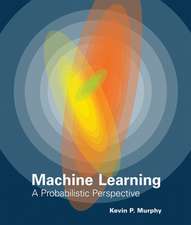Simulating the Evolution of Language
Editat de Angelo Cangelosi, Domenico Parisien Limba Engleză Paperback – 14 noi 2001
Essential reading for researchers and students in the fields of evolutionary and adaptive systems, language evolution modelling and linguistics, it will also be of interest to researchers working on applications of neural networks to language problems. Furthermore, due to the fact that language evolution models use multi-agent methodologies, it will also be of great interest to computer scientists working on multi-agent systems, robotics and internet agents.
Preț: 651.75 lei
Preț vechi: 814.68 lei
-20% Nou
Puncte Express: 978
Preț estimativ în valută:
124.73€ • 129.74$ • 102.97£
124.73€ • 129.74$ • 102.97£
Carte tipărită la comandă
Livrare economică 15-29 aprilie
Preluare comenzi: 021 569.72.76
Specificații
ISBN-13: 9781852334284
ISBN-10: 1852334282
Pagini: 368
Ilustrații: XII, 355 p. 13 illus.
Dimensiuni: 155 x 235 x 19 mm
Greutate: 0.59 kg
Ediția:Softcover reprint of the original 1st ed. 2002
Editura: SPRINGER LONDON
Colecția Springer
Locul publicării:London, United Kingdom
ISBN-10: 1852334282
Pagini: 368
Ilustrații: XII, 355 p. 13 illus.
Dimensiuni: 155 x 235 x 19 mm
Greutate: 0.59 kg
Ediția:Softcover reprint of the original 1st ed. 2002
Editura: SPRINGER LONDON
Colecția Springer
Locul publicării:London, United Kingdom
Public țintă
ResearchCuprins
I Introduction.- 1 Computer Simulation: A New Scientific Approach to the Study of Language Evolution.- 2 An Introduction to Methods for Simulating the Evolution of Language.- II Evolution of Signaling Systems.- 3 Adaptive Factors in the Evolution of Signaling Systems.- 4 Evolving Sound Systems.- 5 The Evolution of Dialect Diversity.- III Evolution of Syntax.- 6 The Emergence of Linguistic Structure: An Overview of the Iterated Learning Model.- 7 Population Dynamics of Grammar Acquisition.- 8 The Role of Sequential Learning in Language Evolution: Computational and Experimental Studies.- IV Grounding of Language.- 9 Symbol Grounding and the Symbolic Theft Hypothesis.- 10 Grounding Symbols through Evolutionary Language Games.- V Behavioral and Neural Factors.- 11 Grounding the Mirror System Hypothesis for the Evolution of the Language-ready Brain.- 12 A Unified Simulation Scenario for Language Development, Evolution, and Historical Change.- VI Auto-organization and Dynamic Factors.- 13 Auto-organization and Emergence of Shared Language Structure.- 14 The Constructive Approach to the Dynamic View of Language.- VII Conclusion.- 15 Some Facts about Primate (including Human) Communication and Social Learning.- Author Index.
Caracteristici
The only book to provide a complete and extensive survey of computational approaches to language evolution











